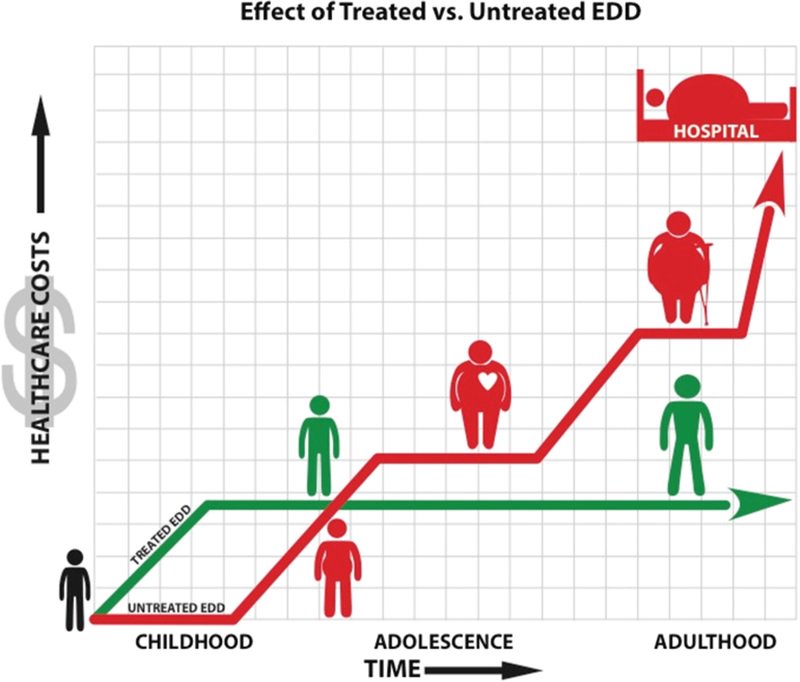Physical activity (or inactivity) is a learned behavior, similar to cigarette smoking. Your child’s behavior is heavily influenced by his or her family, friends, and environment. We, as parents, need to pay greater attention to our children’s lifestyle behaviors to improve their health and prevent disease later in life.
Many chronic diseases (e.g., diabetes and heart disease) that appear during the adult years are influenced by lifestyle habits formed in the growing years. Participation in meaningful physical activities early in life may prevent the development of risk factors and disease in adulthood.
The truth is physically inactive children do not develop fundamental motor skills (e.g., catching, kicking, and hopping) or gain competence and confidence in their ability to move. This makes them less likely to engage in regular exercise. These same children are also more likely to show disease risk factors (e.g., obesity) and eventually experience poor health later in life.
What is Exercise Deficit Disorder?
World health recommendations state that children should accumulate at least 60 minutes of moderate-to-vigorous physical activity each day. Exercise deficit disorder or EDD is a condition characterized by reduced levels of regular physical activity that are below these recommendations.

Infants who are not encouraged to explore their environments and be physically active are prone to increased body fat. Increased body fat during infancy is linked with delayed motor development. Children with poor motor skills tend to avoid physical activity.
This cycle continues through adolescence and early adulthood. Recent reports indicate that 80% of adolescents do not meet the recommended 60 minutes of moderate-to-vigorous physical activity daily. No wonder American adults are becoming increasingly heavier and unhealthy. This does not have to be the case for your child.
The Fall of “Free Play” and the Rise of Adult-Led Activities
Most parents of today can recall their own childhood full of outdoor play in the neighborhood. We had little difficulty meeting physical activity recommendations. We also developed fundamental motor skills by exploring our environments and testing our physical capabilities against other neighborhood children. Of course, we did not realize it but this form of unstructured free play acted as preventative treatment for chronic disease.
Nowadays, computers, devices, and video games have decreased our children’s desire to move. Also, in some communities, crime and perceptions of unsafe conditions understandably limit physical activity in the streets, and at parks and playgrounds. Today, most opportunities for children to be physically active are structured and involve active adult supervision. These adult-led activities take the form of after-school programs, organized sports, and structured classes or lessons in the community.

Unfortunately, there are two main problems with the way today’s children are getting their exercise. First, as stated previously, they are not getting enough moderate-to-vigorous physical activity. Even with organized activities, most children are not physically active enough. Second, and more alarming, today’s children are not developing adequate fundamental motor skills or muscular strength. Early sport specialization, questionable coaching practices, and the ultra-competitive nature of youth sports are likely contributing factors. Lack of motor skill proficiency, poor strength, and low self-confidence contribute to a progressive decline in physical activity (including dropping sports activities). This may increase the likelihood of negative lifestyle choices later in life.
Early Diagnosis & Treatment of Exercise Deficit Disorder
Your child’s pediatrician or healthcare provider diagnoses EDD. A specific exercise history or ‘‘play history’’ identifies physically inactive infants and children before they become resistant to lifestyle treatments. Children and adolescents diagnosed with EDD should be treated with the same urgency as a pediatric patient who has high blood pressure or diabetes.
There are no medications or shots to treat deficiencies in movement skills or physical inactivity. The treatment for EDD is regular physical activity that is age-appropriate and enjoyable. This could include participation in outdoor play, recreational activities, fitness programs, skilled rehabilitation, physical education classes, and sports practice. All of these treatments contribute to the physical and psychosocial development of a child provided they are consistent with the needs, abilities, and interests of your child.
Prescribing the Right Kind of Exercise to Cure Exercise Deficit Disorder
The physical education programs and teachers in Southern Ocean County are some of the best in the nation. Unfortunately, physical education by itself is not enough to overcome the effects of EDD. In order to set our children on the right path for a long and healthy life, physical education teachers need help from parents and community members.
Physical education teachers can help identify physically inactive youth and, with the support of the school district, direct parents to community programs, activities, and professionals. Fitness specialists, coaches, and health care providers (athletic trainers, nurses, and physical therapists) must be trained and skilled in providing developmentally appropriate, safe, meaningful, and enjoyable programs. Children are not miniature adults. They required specialized programs from skilled professionals.

Research has proven that supervised and well-designed strength and conditioning programs are safe and effective for children as young as 6 or 7. One goal of these programs is to increase time spent engaged in physical activity. However, even more important is the development of fundamental movement skills, enhancing strength, building self-confidence, and providing challenges that give children a more positive attitude toward exercise. This will help shape their beliefs and behaviors about physical activity and health for a lifetime.
Pediatric Physical Therapists Help Children Improve Movement and Health for Life
Pediatric physical therapists are skilled in recognizing limitations in fundamental movement skills and muscle strength. Typically children with developmental delays, congenital disorders, or those recovering from injury are referred to a physical therapist. However, many children with EDD never make their way into a physical therapy clinic and thus go undiagnosed and untreated.

Developmentally appropriate and enjoyable exercises work wonders for sedentary children. Your child will benefit from purposely designed activities to target movement deficiencies and weaknesses. If you have concerns about your child’s physical activity levels or sedentary behaviors, a pediatric physical therapist can help diagnose and treat the problem.
The doctors of physical therapy at BSR have been helping people in Southern Ocean County move since 2007. Our pediatric physical therapists are here to help your child move well and lead an active healthy life. Call our Manahawkin clinic at (609) 549-5015 to schedule an initial evaluation with one of our pediatric physical therapists.

